
A brooch is a decorative jewellery item designed to be attached to garments, often to fasten them together. It is usually made of metal, often silver or gold or some other material. Brooches are frequently decorated with enamel or with gemstones and may be solely for ornament or serve a practical function as a clothes fastener. The earliest known brooches are from the Bronze Age. As fashions in brooches changed rather quickly, they are important chronological indicators. In archaeology, ancient European brooches are usually referred to by the Latin term fibula.
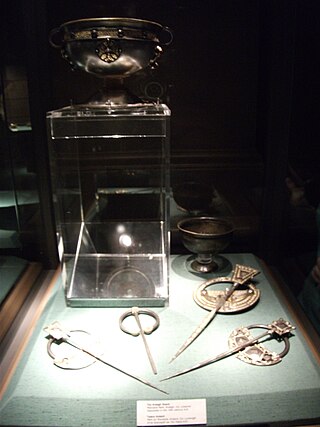
The Ardagh Hoard, best known for the Ardagh Chalice, is a hoard of metalwork from the 8th and 9th centuries. Found in 1868 by two young local boys, Jim Quin and Paddy Flanagan, it is now on display in the National Museum of Ireland in Dublin. It consists of the chalice, a much plainer stemmed cup in copper-alloy, and four brooches — three elaborate pseudo-penannular ones, and one a true pennanular brooch of the thistle type; this is the latest object in the hoard, and suggests it may have been deposited around 900 AD.
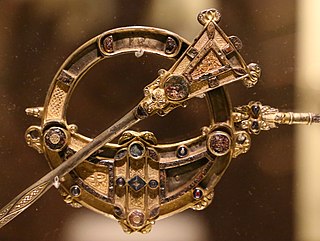
The Tara Brooch is an Irish Celtic brooch, dated to the late-7th or early-8th century. It is of the pseudo-penannular type, and made from bronze, silver and gold. Its head consists of an intricately decorated circular ring, and overall, its front and reverse sides are equally decorated; each holds around 50 inserted cast panels packed with filigree. The brooch was constructed from numerous individually made pieces; all of the borders and its terminals contain multiple panels holding multi-coloured studs, interlace patterns, filigree, and Celtic spirals. The brooch is widely considered the most complex and ornate of its kind and would have been commissioned as a fastener for the cloak of a high-ranking cleric or as ceremonial insignia of high office for a High King of Ireland.
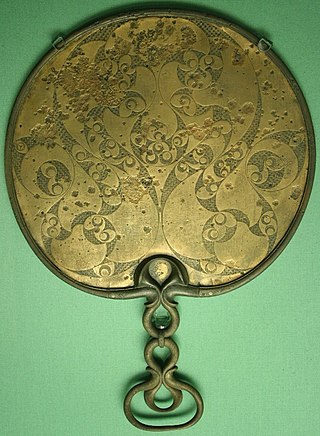
Celtic art is associated with the peoples known as Celts; those who spoke the Celtic languages in Europe from pre-history through to the modern period, as well as the art of ancient peoples whose language is uncertain, but have cultural and stylistic similarities with speakers of Celtic languages.

Migration Period art denotes the artwork of the Germanic peoples during the Migration period. It includes the Migration art of the Germanic tribes on the continent, as well the start of the Insular art or Hiberno-Saxon art of the Anglo-Saxon and Celtic fusion in Britain and Ireland. It covers many different styles of art including the polychrome style and the animal style. After Christianization, Migration Period art developed into various schools of Early Medieval art in Western Europe which are normally classified by region, such as Anglo-Saxon art and Carolingian art, before the continent-wide styles of Romanesque art and finally Gothic art developed.
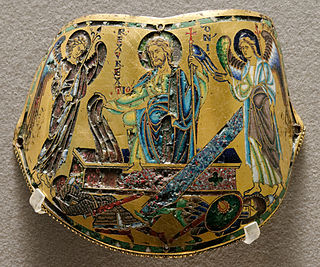
Champlevé is an enamelling technique in the decorative arts, or an object made by that process, in which troughs or cells are carved, etched, die struck, or cast into the surface of a metal object, and filled with vitreous enamel. The piece is then fired until the enamel fuses, and when cooled the surface of the object is polished. The uncarved portions of the original surface remain visible as a frame for the enamel designs; typically they are gilded in medieval work. The name comes from the French for "raised field", "field" meaning background, though the technique in practice lowers the area to be enamelled rather than raising the rest of the surface.
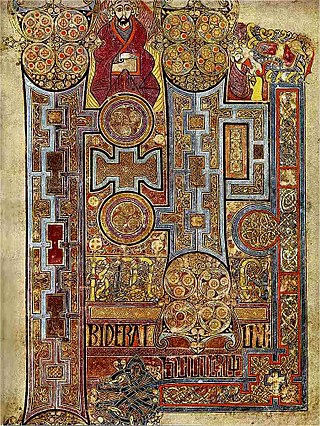
Insular art, also known as Hiberno-Saxon art, was produced in the post-Roman era of Great Britain and Ireland. The term derives from insula, the Latin term for "island"; in this period Britain and Ireland shared a largely common style different from that of the rest of Europe. Art historians usually group Insular art as part of the Migration Period art movement as well as Early Medieval Western art, and it is the combination of these two traditions that gives the style its special character.
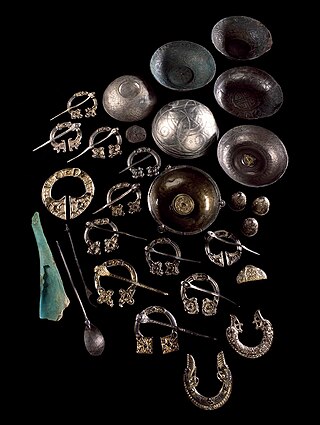
The St Ninian's Isle Treasure, found on St Ninian's Isle, Scotland in 1958 is the best example of surviving silver metalwork from the Early Medieval period in Scotland. The 28-piece hoard includes various silver metalwork items, including twelve pennanular brooches. The treasure is now in the National Museum of Scotland.

The Celtic brooch, more properly called the penannular brooch, and its closely related type, the pseudo-penannular brooch, are types of brooch clothes fasteners, often rather large; penannular means formed as an incomplete ring. They are especially associated with the beginning of the Early Medieval period in Ireland and Britain, although they are found in other times and places—for example, forming part of traditional female dress in areas in modern North Africa.

The Hunterston Brooch is a highly important Celtic brooch of "pseudo-penannular" type found near Hunterston, North Ayrshire, Scotland, in either, according to one account, 1826 by two men from West Kilbride, who were digging drains at the foot of Goldenberry Hill, or in 1830. It is now in the National Museum of Scotland, Edinburgh. Made within a few decades of 700 AD, the Hunterston Brooch is cast in silver, gilt, and set with pieces of amber, and decorated with interlaced animal bodies in gold filigree. The diameter of the ring is 12.2 cm, and in its centre there is a cross and a golden glory representing the risen Christ, surrounded by tiny bird heads. The pin, which is broken, can travel freely around the ring as far as the terminals, which was necessary for fastening; it is now 13.1 cm long, but was probably originally 15 cm or more.

The National Museum of Ireland – Archaeology is a branch of the National Museum of Ireland located on Kildare Street in Dublin, Ireland, that specialises in Irish and other antiquities dating from the Stone Age to the Late Middle Ages.

In the early Middle Ages, there were distinct material cultures evident in the different federations and kingdoms within what is now Scotland. Pictish art was the only uniquely Scottish medieval style; it can be seen in the extensive survival of carved stones, particularly in the north and east of the country, which hold a variety of recurring images and patterns. It can also be seen in elaborate metal work that largely survives in buried hoards. Irish-Scots art from the kingdom of Dál Riata suggests that it was one of the places, as a crossroads between cultures, where the Insular style developed.

The Londesborough Brooch is a Celtic pseudo-penannular brooch from Ireland. Dating from the late eighth or early ninth century, it is a particularly elaborate example of a dress fastener dated to Ireland's artistic golden age, when objects such as the Tara Brooch and Ardagh Chalice were produced. Since 1888, it has been part of the British Museum's collection.

Norrie's Law hoard is a sixth century silver hoard discovered in 1819 at a small mound in Largo, Fife, Scotland. Found by an unknown person or persons, most of the hoard was illegally sold or given away, and has disappeared. Remaining items of the hoard were found later at the mound, and were turned over to the landowner, General Philip Durham. The surviving 170 pieces from the hoard are now in the National Museum of Scotland. The treasure consists mostly of hacksilver and includes four complete silver pieces. Both Roman and much rarer Pictish objects are among the survivals.

Sculpture in Scotland includes all visual arts operating in three dimensions in the borders of modern Scotland. Durable sculptural processes traditionally include carving and modelling, in stone, metal, clay, wood and other materials. In the modern era these were joined by assembly by welding, modelling, moulding and casting. Some installation art can also be considered to be sculpture. The earliest surviving sculptures from Scotland are standing stones and circles from around 3000 BCE. The oldest portable visual art are carved-stone petrospheres and the Westray Wife is the earliest representation of a human face found in Scotland. From the Bronze Age there are extensive examples of rock art, including cup and ring marks and elaborate carved stone battle-axes. By the early Iron Age Scotland had been penetrated by the wider European La Tène culture, and a few examples of decoration survive from Scotland. There are also decorated torcs, scabbards, armlets and war trumpets. The Romans began military expeditions into what is now Scotland from about 71 CE, leaving a direct sculptural legacy of distance slabs, altars and other sculptures.

Scottish jewellery is jewellery created in Scotland or in a style associated with Scotland, which today often takes the form of the Celtic style. It is often characterised by being inspired by nature, Scandinavian mythology, and Celtic knot patterns. Jewellery has a history in Scotland dating back to at least the Iron Age.

Anglo-Saxon brooches are a large group of decorative brooches found in England from the fifth to the eleventh centuries. In the early Anglo-Saxon era, there were two main categories of brooch: the long (bow) brooch and the circular (disc) brooch. The long brooch category includes cruciform, square-headed, radiate-headed, and small-long brooch brooches. The long brooches went out of fashion by the end of the sixth century.
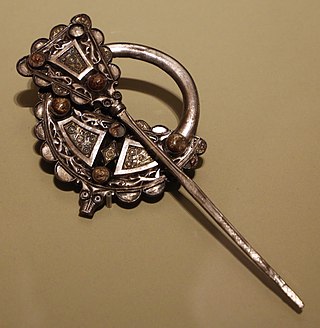
The Roscrea brooch is a 9th-century Celtic brooch of the pseudo-penannular type, found at or near Roscrea, County Tipperary, Ireland, before 1829. It is made from cast silver, and decorated with zoomorphic patterns of open-jawed animals and gilded gold filigree, and is 9.5 cm in height and 8.3 cm wide. The silver is of an unusually high quality for Irish metalwork of the period, indicating that its craftsmen were both trading materials with settled Vikings, who had first, traumatically, invaded the island in the preceding century, and had absorbed elements of the Scandinavian's imagery and metalwork techniques.
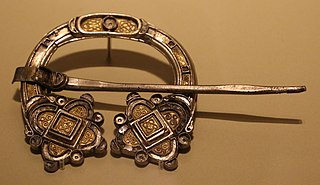
The Kilmainham Brooch is a late 8th- or early 9th-century Celtic brooch of the "penannular" type. With a diameter of 9.67 cm, it is a relatively large example, and is made from silver, gold and glass, with filigree and interlace decorations. Like other high-quality brooches of its class, it was probably intended to fasten copes and other vestments rather than for everyday wear, as its precious metal content would have made it a status symbol for its owner; less expensive Viking-style brooches were typically worn in pairs on women's clothing.

The Ballinderry Brooch is an Irish penannular brooch dated to the late 6th or early 7th centuries. It was found in the 1930s, along with a number of similar objects, underneath a timber floor of the late Bronze Age Ballinderry Crannóg No.2, on Ballinderry lake, County Offaly. Made from copper-alloy, tin and enamel, and decorated with millefiori patterns, it is relatively small, with a maximum ring diameter of 8.6 cm, while its pin is 18.3 cm long.




















